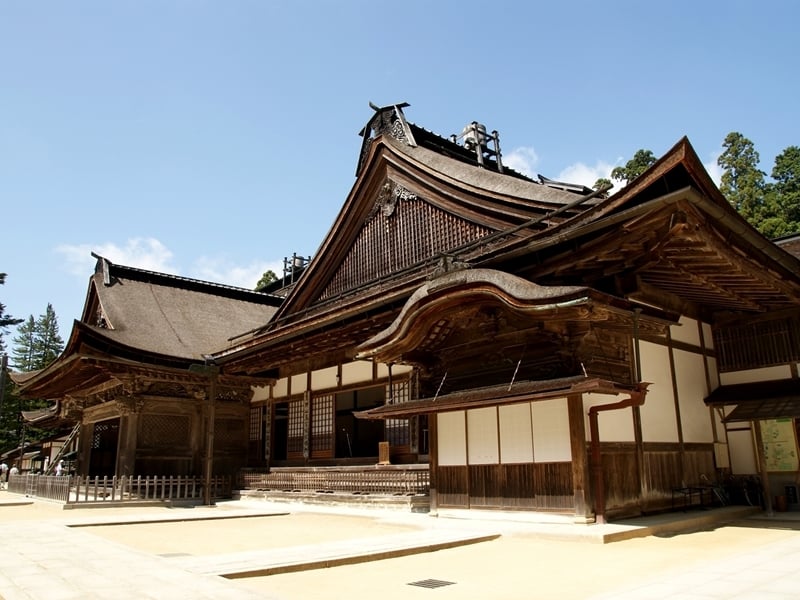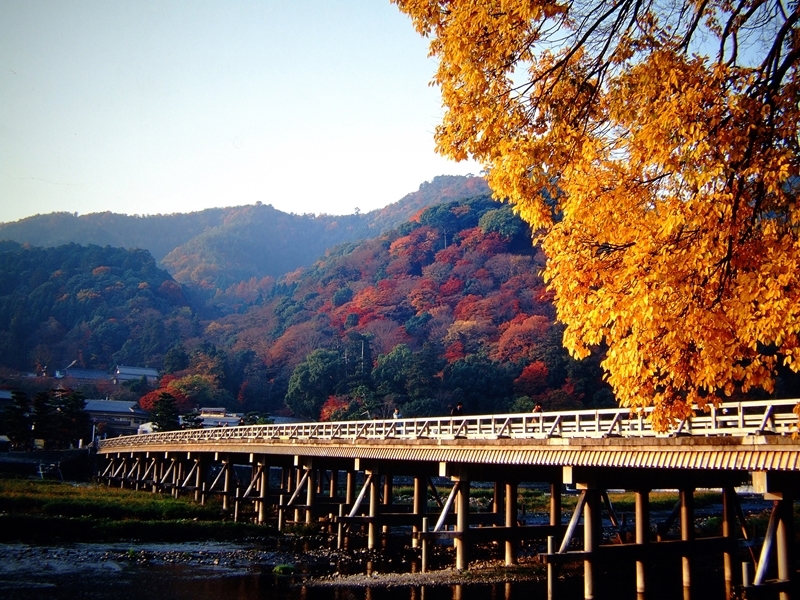Explore the fascinating roots of Japanese culture with a two-week tour of the country’s UNESCO sites. From the famed geisha-filled streets of Kyoto to the lesser-known grass houses of Shirakawago, this insightful holiday delves deep into the traditions and customs of one of the world’s most intriguing destinations.
Itinerary
📍 Narita International Airport (NRT) to Central Tokyo: 1.5 h Haneda International Airport (HND) to Central Tokyo: 50 min
Upon arrival to Tokyo’s airport, one of our representatives will be waiting to assist with transport to the hotel (boarding the right train or finding the appropriate shuttle van.)
The rest of the day is at leisure.
Overnight in Tokyo
Inclusions:
📍 Start (guided tour): 09:00 Duration: 8 h *including pick-up/drop-off and transit times
Meet up with the guide this morning in the hotel for the trip to Meiji Jingu, Tokyo’s most iconic Shinto shrine steeped in history and spirituality. Pass through the impressive torii gates leading to the shrine's inner forest of over 100,000 trees. Whether witnessing a traditional Shinto wedding procession or strolling through the lush grounds, Meiji Jingu provides an unforgettable experience of nature in the centre of Tokyo’s urban landscape.
Move on to the nearby districts of Harajuku and Omotesando, vibrant neighbourhoods that offer a unique and eclectic experience. Harajuku, renowned for its quirky street fashion, showcases an array of avant-garde boutiques and shops that cater to various subcultures. Omotesando, often dubbed Tokyo's "Champs-Élysées" presents a sharp contrast with its upscale, sophisticated atmosphere.
After lunch, use public transport to reach the beautiful Koishikawa Korakuen Garden, a traditional landscape that serves as an excellent example of Japanese garden design.
The final destination of the day is Asakusa. This charming district exudes a nostalgic charm and showcases
Tokyo's traditional side. At the heart of Asakusa stands the iconic Senso-ji, Japan's oldest Buddhist temple, drawing hordes of locals and tourists alike seeking blessings and cultural insight. The vibrant Nakamise Street leading to the temple offers a bustling market with a myriad of stalls selling traditional snacks, souvenirs, and handicrafts.
After a full day of touring the city, return to the hotel with the guide or part ways and continue exploring the city independently.
Note: The order of this itinerary may change depending on the location of your hotel.
Overnight in Tokyo
Inclusions:
☕ Breakfast
📍 Tokyo Station to Kamakura Station: 50 min
Today is a self-guided day.
Suggested Self-Guided Itinerary:
Spend the entire day exploring this amazing city. Visit the electronics district of Akihabara or discover some of Tokyo’s world-class museums and art galleries.
Alternatively, use the included Japan Rail Pass for a day trip to Kamakura. One of Japan’s former capitals, Kamakura is a delightful seaside town home to many ancient shrines, temples, and other structures like the Daibutsu, a giant bronze Buddha that stands at 13-meter tall.
Optional Tour: Tokyo Street Food Tour
Be sure to bring an appetite: This is one Tokyo street food tour that is sure to please the taste buds! Meet with a local, food-loving guide at the train station and set off into the streets for a Japan-style food crawl.
Veer off into the maze of laneways that fill the capital, passing street carts selling exotic snacks and diners perched on small metal stools. Stop to sample some of the items on offer, from barbequed meats to sweet desserts. Then enter an izakaya for a distinctly Japanese experience. These small, Japanese-style pubs are popular gathering places for friends and colleagues to gather after work for a beer. The food on offer is meant to be shared and is thus served almost like tapas. The guide will order up a few traditional izakaya favourites such as fried chicken wings or cold edamame. Sample the dishes and wash them down with a cold, local beer alongside the locals.
While dining, learn more about Japan’s culinary culture by observing the lively surroundings and hearing the guide’s personal stories. During the evening, stop at four or five venues, each with a distinctive style. These venues do not take reservations so the exact routing may change but the guide will ensure there is plenty to eat! Following an evening of culinary and cultural indulgence, return to the hotel for a good night’s sleep.
Time:
Start: 17:00
Duration: 3.5 h
Overnight in Tokyo
Inclusions:
☕ Breakfast
📍 Tokyo Station to Takayama Station: 4.5 h
Today is a self-guided day.
Depart for the journey to Takayama, a small town nestled high in the Hida Alpine region of Gifu Prefecture.
The first leg of the trip will be on a bullet train that can reach speeds of up to 260 k/h. Next is on the limited express train Wide View, which offers one of the most scenic train journeys in Japan.
Suggested Self-Guided Itinerary:
We recommend strolling in Takayama’s shitamachi, where the streets are lined with century-old merchants’ homes and sake breweries. Stop by one of the breweries for a taste of the local drop or queue for the famous Hida beef sushi in one of the special food stalls.
In Takayama, experience a stay in a ryokan, the traditional Japanese-style inn furnished with low tables and chairs, sliding shoji doors, and tatami flooring.
Overnight in Takayama
Inclusions:
☕ Breakfast, 🍗 Dinner
📍 Takayama Bus Terminal to Shirakawago Bus Stop: 50 min
Today is a self-guided day.
Optional Tour: Food & Culture Walk and Hida Cycling Tour
Explore some of the food shops in Takayama with a knowledgeable guide, learning about the town’s colorful history and familiarizing the taste buds with some local delicacies. The walking tour includes visits to a tofu seller, a rakugan shop (traditional Japanese candies) and even a sake brewery (some stores may close during certain days). Food and sake tastings are also included.
Follow up with a cycling tour in Hida Furukawa, a small, quiet farm village in Gifu Prefecture located 15 minutes away from Takayama.
With an impressive view of the surrounding Japanese Alps, it is also well-known for the traditional architectural design of its old buildings and machiya-style houses built by experienced craftsmen centuries ago.
Like other towns in the Hida Region, Hida Furukawa is also famous for its high-quality sake (rice wine) brought about by its rich rice fields, clean waters and favorable weather.
Today, get a chance to explore the streets and outskirts of Hida Furukawa on a bicycle together with a local guide. Spend half a day cycling around this mountain village, passing by rice paddies and old houses, and have a closer look at the lifestyle in this rural region.
Time:
Start: 09:30
Duration (approximation): 6.5 - 7.5 h
Availability:
April to October: 09:30 – 17:00
November to December: 09:30 – 16:00
Notes:
Transfer to and from the designated meeting point is under own arrangement.
Tour dates, especially right before and after winter, may be altered depending on a number of factors (i.e. snow, weather, sunset times, etc.).
Note: This activity can be arranged at an additional cost.
Overnight in Takayama
*Guest staying at Ryokan Asunaro, dinner is not included tonight
Inclusions:
☕ Breakfast, 🍗 Dinner
📍 Takayama Bus Terminal to Shirakawago Bus Stop: 1 h Shirakawago Bus Stop to Kanazawa Eki-mae Bus Terminal: 1 - 1.5 h 75 min
Today is a self-guided day.
This morning, catch the bus to Shirakawago, a UNESCO World Heritage Site famous for its gassho-zukuri farmhouses.
Gassho-zukuri means "constructed like hands in prayer," which is represented through the farmhouses' steep thatched roofs. This architectural style developed over many generations – the roofs were constructed without any nails and are intricately designed to withstand large amounts of snow.
These houses are private homes of the locals, but some are open to the public, such as Wada House, a legacy left behind by the Wada Family who used to be the richest family and village leader in Ogimachi.
In the afternoon, continue by bus to Kanazawa, the castle town that thrived as the center for culture and the arts in the 17th century.
Overnight in Kanazawa
Inclusions:
☕ Breakfast
📍 Kanazawa Station to Kyoto Station: 2 h 15 min
Today is a self-guided day.
Suggested Self-Guided Itinerary:
Start with the pristine Kenroku-en Garden, which is ranked as one of Japan’s top three gardens. Here you will find the oldest water fountain in the country, a couple of teahouses, and a large villa that used to be the retirement home of one of the richest clans in Kanazawa.
Adjacent to the garden is Kanazawa Castle, easily accessed through the Ishikawa-mon Gate, a designated Important National Cultural Asset.
Lunch can be in Omicho Market, known throughout Japan for its fresh seafood and fine sushi.
Finally, head across town to the old Samurai district of Kanazawa and visit Nomura House, a restored residence of a high ranked samurai family. Freshly made green tea can be enjoyed on the second floor while viewing the small Japanese garden below.
In the afternoon, travel by limited express train to Kyoto, Japan’s cultural capital and home to around 2,000 shrines and temples, including 17 UNESCO World Heritage Sites.
Overnight in Kyoto
Inclusions:
☕ Breakfast
📍 Start (guided tour): 09:00 Duration: 8 h *including pick-up/drop-off and transit times
Today’s tour starts with a visit to one of Kyoto’s most iconic sites: the Fushimi Inari Shinto Shrine. A lavishly decorated building houses the goddess of rice, and thousands of orange torii gates stretch up the mountainside in long tunnels. Unlike any other shrine in Japan, this is an ideal spot to understand how Shintoism is tied to respect for nature.
Board a train to Sanjusangendo, a stunning Buddhist temple often overlooked by tourists. A mesmerizing display of 1001 life-sized golden Buddhist statues awaits inside the world’s longest wooden building, sure to be one of the most memorable sights of the entire trip.
Take a taxi to the entrance of Nishiki Market, a long covered street of shops and stalls often called “Kyoto’s kitchen.” From traditional to sellers of tofu, fish, and pickles to shops showcasing knives and handicrafts, there is a tantalizing amount of things to see and taste here.
Don’t get too full snacking in the market, as lunch is next at a nearby restaurant. The guide will suggest locations based on the guests’ preferences (guests should notify guide of dietary restrictions at the start of the tour).
After lunch, travel to Nijo Castle, an ornamental palace built for the shogun in the early 1600s. The beautiful building is known for its finely painted walls and “chirping nightingale” floors that squeak under the feet of intruders. Walk the halls, see the audience chambers, and experience what it was like to visit the military ruler of Japan in the classic era of samurai.
Hop aboard the subway for a short ride to the eastern foothills of Kyoto. The final location of today is Nanzenji Zen Temple, a quiet retreat where monks have lived in peaceful repose since 1291. See the famous Zen rock garden whose meaning is left up to the viewer. Is it meant to be islands in a calm ocean, or a depiction of wild animals crossing a raging river?
After a full day of sightseeing, part ways with the guide and return to the hotel or continue to explore independently.
Part ways with the guide and continue exploring the city independently.
Overnight in Kyoto
Inclusions:
☕ Breakfast
📍 Start (cultural activity): 09:30, 12:00 or 14:30 Duration: 2 h
Be immersed in Japanese culture with this insightful half day trip in Kyoto. Start with a visit to a machiya, a traditional wooden townhouse found throughout Kyoto. Take a tour of the beautifully restored house, learning about its architecture and history.
Then slip into a kimono, the iconic traditional Japanese garment. These full-length robes are worn by all Japanese when attending important events or formal occasions. Once appropriately dressed, meet with a local tea master for a traditional ceremony. Watch and learn as the master brews and services tea using slow, deliberate movements steeped in spirituality and ritual. Enjoy a cup of the bitter tea along with traditional sweet treats.
After the tea is finished, continue the cultural exploration of Kyoto. Experience an introductory course in origami, the Japanese art of paper folding. Under the guidance of a local artist, learn the secrets behind creating beautiful decorations and images with simple pieces of paper.
Wrap up the half day trip in Kyoto with new insights and a better understanding of Japanese culture. Return to the hotel or continue to explore Kyoto’s charming streets.
Overnight in Kyoto.
Inclusions:
☕ Breakfast
📍 Kyoto Station to Nara Station: 45 min
Today is a self-guided day.
Suggested Self-Guide Itinerary:
In the afternoon, there is an option to go out of town and travel to Nara using the Japan Rail Pass. For 74 years during the 8th century, Nara was Japan’s capital and many of the temples and shrines built at that time still remain.
Nara is just a small town, with most of its main tourist spots located around Nara Park. It’s also here that one can encounter quite a great number of tame deer. Visit Todaiji Temple, the world’s largest wooden building home to Japan’s largest Buddha, or Kasuga Taisha, Nara’s most celebrated shrine.
Overnight in Kyoto
Inclusions:
☕ Breakfast
📍 Kyoto Station to Koyasan Station: 3 h Time: Start (guided tour): 9:30 Duration: 6 h *including pick-up/drop-off and transit times
Head to Osaka and meet the guide at Osaka Namba Station. Pass through river valleys and forested slopes as the train snakes its way into the mountains of Wakayama Prefecture, once thought to be home to ancient gods of nature. The final approach is made on Japan’s steepest cable car.
Welcome to Koyasan, a small community of over 100 temples of the secretive Shingon sect of esoteric Buddhism. This mountain enclave has endured for over 1,200 years, and remains a fascinating relic of a time when religion governed the politics and daily life of historic Japan.
Meet the guide at Koyasan Station and spend the afternoon exploring what Shingon followers believe is the center of the spiritual universe.
Visit Kongobuji, the head temple of Shingon Buddhism, home to Japan’s largest rock garden. Peek into beautifully decorated historic rooms and see the cavernous wooden kitchen where meals are still prepared for monks on special occasions.
Enter the brightly painted Konpon Daito Pagoda, which houses an awe-inspiring altar in the form of a three dimensional mandala that maps out the Buddhist cosmos with towering statues. This staggering sight is sure to evoke a sense of wonder in any onlooker.
Continue on to Okuno-in, Japan’s largest and most important cemetery. More than 200,000 gravestones are piled up in the shady spaces between soaring cypress trees, and the trail through this mossy landscape stretches for 2km. At the end lies the solemn Torodo Lantern Hall, where priests chant and eternal flames burn in memory of the deceased. Beyond is the final treasure of Koyasan: the mausoleum of Kobo Daishi, the founder of Shingon Buddhism and a pivotal figure in Japanese history.
After this remarkable journey through the spiritual past of Japan, guests are escorted to their shukubo (temple lodging) for the evening. A delicious shojin ryori vegetarian Buddhist dinner is served in a delightfully traditional atmosphere.
Overnight at Koyasan
Inclusions:
☕ Breakfast, 🍗 Dinner
📍 Koyasan Station to Miyajima-guchi Station: 5 h Miyajima-guchi Port to Miyajima Port: 10 min
Today is a self-guided day.
Join the optional morning prayer service at the temple lodging, which usually starts at 06:00, to hear the priests chant and drum as they greet the morning. Vegetarian breakfast is served after the service.
Before noon, start the long journey to Miyajima, a small sacred island located in the Seto Inland Sea.
Overnight in Miyajima
Inclusions:
☕ Breakfast, 🍗 Dinner
📍 Start (guided tour): 09:00 Duration: 8 h *including pick-up/drop-off and transit times
Together with the guide, explore the island and sample some local delicacies like oysters, saltwater eel, and maple leaf-shaped cakes.
Start with Itsukushima Shrine, declared as one of Japan’s three most beautiful views. The shrine is designed in a pier-like structure and dates back to the 6th century. Its huge vermillion o-torii gate seems to be floating in the water during high tide.
Walk towards the mountain to visit Daisho-in, the most visited Buddhist temple on the island. Along the stairs is a row of spinning sutras that lead up to the main hall. It is believed that anyone who spins these sutras will be blessed.
Early in the afternoon head to Hiroshima to visit Peace Memorial Park and Museum. There is also the heart-rending A-Bomb Dome and the Children’s Peace Monument.
Overnight in Miyajima
Inclusions:
☕ Breakfast, 🍗 Dinner
📍 Miyajima Port to Miyajima-guchi Port: 10 min Miyajima-guchi Station to Shin-Osaka Station: 2 h
Today is a self-guided day.
Suggested Self-Guide Itinerary:
In Osaka, the following places are recommended:
Dotonbori
Dotonbori is a restaurant mecca which has long-been referred to as Osaka’s entertainment district. It is well-known for its bright neon lights, energetic shop owners and food stalls that are filled with some local Osakan delights such as takoyaki (octopus balls) and fugu (poisonous puffer fish).
Umeda
Umeda is where most of the city’s most modern buildings are found. Some of the notable buildings are HEP (Hankyu Entertainment Park), which features a big Ferris wheel and is perfect for some last-minute shopping; Kitashinchi District, housing some of the city’s culinary specialties; and the Umeda Sky Building, a pair of skyscrapers connected in “mid-air”, built in an unusual architectural form rarely seen anywhere in the world. Feel the fresh air and enjoy 360-degree panoramic views at the ‘Floating Garden Observatory’.
Optional Tour: Flavours of Osaka Food Tour
Today’s tour begins at 17:00 or 18:00 depending on whether it is shared or private. Osaka is an epicurean’s delight. Indeed, the motto that the city’s exuberant inhabitants live by is kuidaore – “to eat oneself bankrupt.”
The first stop will be to try a new style of tempura in an eatery tucked away in a small alleyway. Old favourites such as shrimp tempura, and more experimental combinations such as asparagus tempura and cheese can be found on the menu.
Next, head to a restaurant specialising in wagyu beef dishes. Often referred to as the most expensive beef in the world, wagyu beef is of a superb quality, and is on many a gourmet’s wish list. Enjoy the melt-in-the-mouth textures with a refreshing cocktail.
After walking around the atmospheric backstreets, the final stop will be a small teppanyaki restaurant to try some delicious gyoza and negiyaki cooked on a metal plate right in front of guests.
Bid farewell to the affable guide, and either return to the hotel or go for a stroll around the neighbourhood to take in the sights. (D)
Time:
Start: 17:00
Duration: approx. 3.5 h
Overnight in Osaka.
Inclusions:
☕ Breakfast
📍 Namba Station to Kansai Airport: 45 min
The rest of the day is at leisure until the scheduled transfer by train to Kansai International Airport.
Inclusions:
☕ Breakfast
You might also like...
Here is a selection of products that may also fit the needs of your client.
Become a partner-
You might also like...
Here is a selection of products that may also fit the needs of your client.
Become a partner -
-
-
Get in touch
Our sales team is on hand to ensure that the process of working with us is as smooth as possible. If you should have any questions, feel free to reach out to them.
















